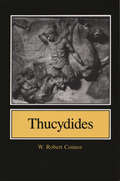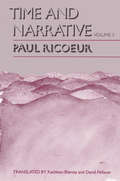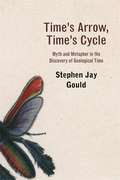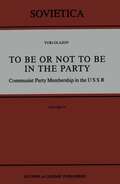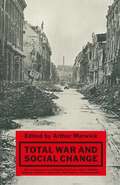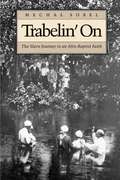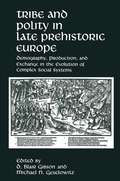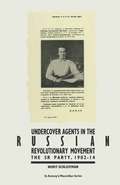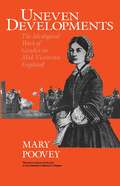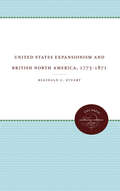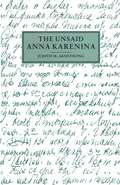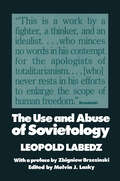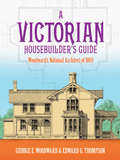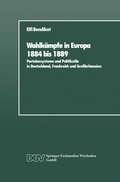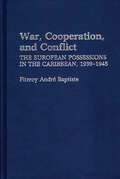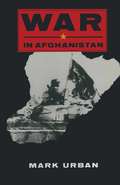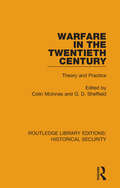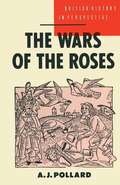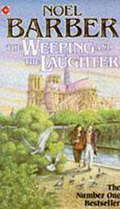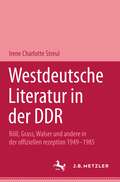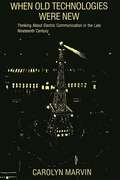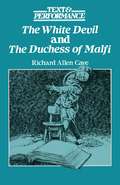- Table View
- List View
Thucydides
by Walter Robert ConnorThis full-scale sequential reading of Thucydides' history of the Peloponnesian War will be invaluable to the specialist and also to those in search of an introduction and companion to the Histories. Moving beyond other studies by its focus on the reader's role in giving meaning to the text, it reveals Thucydides' use of objectivity not so much as a standard for the proper presentation of his subject matter as a method for communicating with his readers and involving them in the complexity and suffering of the Peloponnesian War. W. Robert Connor shows that as Thucydides' themes and ideas are reintroduced and developed, the initial reactions of the reader are challenged, subverted, and eventually made to contribute to a deeper understanding of the war.
Thucydides
by Walter Robert ConnorThis full-scale sequential reading of Thucydides' history of the Peloponnesian War will be invaluable to the specialist and also to those in search of an introduction and companion to the Histories. Moving beyond other studies by its focus on the reader's role in giving meaning to the text, it reveals Thucydides' use of objectivity not so much as a standard for the proper presentation of his subject matter as a method for communicating with his readers and involving them in the complexity and suffering of the Peloponnesian War. W. Robert Connor shows that as Thucydides' themes and ideas are reintroduced and developed, the initial reactions of the reader are challenged, subverted, and eventually made to contribute to a deeper understanding of the war.
Time and Narrative, Volume 3 (Time And Narrative Ser. #Vol. 3)
by Paul RicoeurIn the first two volumes of this work, Paul Ricoeur examined the relations between time and narrative in historical writing, fiction, and theories of literature. This final volume, a comprehensive reexamination and synthesis of the ideas developed in volumes 1 and 2, stands as Ricoeur's most complete and satisfying presentation of his own philosophy. Ricoeur's aim here is to explicate as fully as possible the hypothesis that has governed his inquiry, namely, that the effort of thinking at work in every narrative configuration is completed in a refiguration of temporal experience. To this end, he sets himself the central task of determing how far a poetics of narrative can be said to resolve the "aporias"—the doubtful or problematic elements—of time. Chief among these aporias are the conflicts between the phenomenological sense of time (that experienced or lived by the individual) and the cosmological sense (that described by history and physics) on the one hand and the oneness or unitary nature of time on the other. In conclusion, Ricoeur reflects upon the inscrutability of time itself and attempts to discern the limits of his own examination of narrative discourse. "As in his previous works, Ricoeur labors as an imcomparable mediator of often estranged philosophical approaches, always in a manner that compromises neither rigor nor creativity."—Mark Kline Taylor, Christian Century "In the midst of two opposing contemporary options—either to flee into ever more precious readings . . . or to retreat into ever more safe readings . . . —Ricoeur's work offers an alternative option that is critical, wide-ranging, and conducive to new applications."—Mary Gerhart, Journal of Religion
Time’s Arrow, Time’s Cycle: Myth and Metaphor in the Discovery of Geological Time (The Jerusalem-Harvard lectures)
by Stephen Jay GouldRarely has a scholar attained such popular acclaim merely by doing what he does best and enjoys most. But such is Stephen Jay Gould’s command of paleontology and evolutionary theory, and his gift for brilliant explication, that he has brought dust and dead bones to life, and developed an immense following for the seeming arcana of this field. In Time’s Arrow, Time’s Cycle his subject is nothing less than geology’s signal contribution to human thought—the discovery of “deep time,” the vastness of earth’s history, a history so ancient that we can comprehend it only as metaphor. He follows a single thread through three documents that mark the transition in our thinking from thousands to billions of years: Thomas Burnet’s four-volume Sacred Theory of the Earth (1680–1690), James Hutton’s Theory of the Earth (1795), and Charles Lyell’s three-volume Principles of Geology (1830–1833). Gould’s major theme is the role of metaphor in the formulation and testing of scientific theories—in this case the insight provided by the oldest traditional dichotomy of Judeo-Christian thought: the directionality of time’s arrow or the immanence of time’s cycle. Gould follows these metaphors through these three great documents and shows how their influence, more than the empirical observation of rocks in the field, provoked the supposed discovery of deep time by Hutton and Lyell. Gould breaks through the traditional “cardboard” history of geological textbooks (the progressive march to truth inspired by more and better observations) by showing that Burnet, the villain of conventional accounts, was a rationalist (not a theologically driven miracle-monger) whose rich reconstruction of earth history emphasized the need for both time’s arrow (narrative history) and time’s cycle (immanent laws), while Hutton and Lyell, our traditional heroes, denied the richness of history by their exclusive focus upon time’s arrow.
To Be or Not to Be in the Party: Communist Party Membership in the USSR (Sovietica #54)
by Yuri GlazovIn March of 1985 Mikhail Gorbachev came to power in the Seviet Union. Initially, one could discern serious changes in the policy and statements of this new, young, and obviously efficient leader only with great difficulty. While abroad, Gorbachev had said that anti-Stalinism was a form of anti-Communism. The newspapers were filled with words lauding "the sacred traditions of the 1930's". At the same time, the campaign against drunkenness, corruption, and sloppiness launched by Yuri Andropov was given a new impetus and the highest Party support. In April, 1986, the Chernobyl tragedy took place. The first reaction of the Soviet authorities was the usual one. The Soviet public was not properly informed about the disaster and its unprecedented peril. Millions of jubilant Soviet citizens crowded the squares and streets of Kiev and Minsk during the May Day festivities. We can only guess what the reaction of the Kremlin authorities would have been had not Swedish scientists traced and announced to the world the threatening level of radioactivity. Would the terms "glasnost'" and "perestrojka" have spread through the world press with such intensity and alacrity? A popular Soviet author wrote a year later in the Soviet media: "Chernobyl appeared to be not only a national event, a disaster shared by each of us, but also a dividing line between two eras of time.
Total War and Social Change
by Arthur MarwickA collection of essays supported by statistics on the social consequences of the two world wars. It covers the main European countries and a range of major issues including the levels of economic activity, women's employment and the extent of executions of collaborators.
Trabelin' On: The Slave Journey to an Afro-Baptist Faith. Abridged Paperback
by Mechal SobelMechal Sobel's fascinating study of the religious history of slaves and free blacks in antebellum America is presented here in a compact volume without the appendixes. Sobel's central thesis is that Africans brought their world views into North America where, eventually, under the tremendous pressures and hardships of chattel slavery, they created a coherent faith that preserved and revitalized crucial African understandings and usages regarding spirit and soul-travels, while melding them with Christian understandings of Jesus and individual salvation.
Tribe and Polity in Late Prehistoric Europe: Demography, Production, and Exchange in the Evolution of Complex Social Systems
by D. Blair Gibson Michael N. GeselowitzDuring HaA-HaB, many settlements were established in Silesia and in the central part of Poland, and their stability seems to be confirmed by the existence of regional groups and subgroups, by long-lasting colonies, and by long-used burial grounds, located at large settlements. At the end of HaB, many pre-Scythian elements occurred in this area, only partly influenced by the Cimmerians . During that period the peoples living north of the Carpathian and Sudeten Mountains remained very dependent on the productive and cultural circle south of the Carpathians, with which they maintained strong connections . The Lusatian settlement zone , apart from its increasing internal stability, also tended to extend its range . A partition of the Lusatian Culture, which had appeared earlier , became more pronounced under the strong influence of the East Hallstatt cultural and productive center in the eastern Alpine region , and the so-called amber route . The eastern zone of the Lusatian Culture remained under the influence of the Carpathian center, while the western zone was strongly influenced by the pre-Celtic (Bylanska or Horakowska) and northern Illyrian (Calon denberian) cultures. In HaD2' ca. 520-500 B.C., this latter area was the site of an armed incursion of Scythian groups coming from the east through the Karpacka Valley. The most characteristic features of the western zone include its own varieties of more general Hallstatt traits , such as fortified settlements (which date from HaA in the Lusatian Culture) , production of iron (done domestically since HaD), and decorated pottery.
Undercover Agents in the Russian Revolutionary Movement: The Sr Party 1902-1914 (St Antony's Series)
by Nurit SchleifmanUneven Developments: The Ideological Work of Gender in Mid-Victorian England (Women in Culture and Society)
by Mary PooveyMary Poovey's The Proper Lady and the Woman Writer has become a standard text in feminist literary discourse. In Uneven Developments Poovey turns to broader historical concerns in an analysis of how notions of gender shape ideology. Asserting that the organization of sexual difference is a social, not natural, phenomenon, Poovey shows how representations of gender took the form of a binary opposition in mid-Victorian culture. She then reveals the role of this opposition in various discourses and institutions—medical, legal, moral, and literary. The resulting oppositions, partly because they depended on the subordination of one term to another, were always unstable. Poovey contends that this instability helps explain why various institutional versions of binary logic developed unevenly. This unevenness, in turn, helped to account for the emergence in the 1850s of a genuine oppositional voice: the voice of an organized, politicized feminist movement. Drawing on a wide range of sources—parliamentary debates, novels, medical lectures, feminist analyses of work, middle-class periodicals on demesticity—Poovey examines various controversies that provide glimpses of the ways in which representations of gender were simultaneously constructed, deployed, and contested. These include debates about the use of chloroform in childbirth, the first divorce law, the professional status of writers, the plight of governesses, and the nature of the nursing corps. Uneven Developments is a contribution to the feminist analysis of culture and ideology that challenges the isolation of literary texts from other kinds of writing and the isolation of women's issues from economic and political histories.
United States Expansionism and British North America, 1775-1871
by Reginald C. StuartThis sweeping study surveys nearly a century of diverse American views on the relationship between the United States and the Canadian provinces, filling out a neglected chapter in the history of aggressive U.S. expansionism. Until the mid-nineteenth century, many believed that Canada would ultimately join the United States. Stuart provides an insightful view of the borderland, the Canadian-American frontier where the demographics, commerce, and culture of the two countries blend.Originally published in 1988.A UNC Press Enduring Edition -- UNC Press Enduring Editions use the latest in digital technology to make available again books from our distinguished backlist that were previously out of print. These editions are published unaltered from the original, and are presented in affordable paperback formats, bringing readers both historical and cultural value.
The Use and Abuse of Sovietology
by Leopold Labedz"This is a work by a fighter, a thinker, and an idealist. Leo Labedz is a fighter who minces no words in his contempt for the apologists of totalitarianism. He never rests in his efforts to enlarge the scope of human freedom, and many have felt the sharp edge of his political scalpel. He is a thinker with a penetrating mind and encyclopedic knowledge. He is an idealist who believes in sacrificing for the just cause to which he has dedicated his life." With these words of extraordinary praise, Zbigniew Brzezinski opens this volume of critical and polemical essays by Leopold Labedz. His knowledge of Soviet affairs, as seen through the eyes of the crusaders and critics of the Modern Russian State, is peerless. Chapters, which include major studies of Alexandr Solzhenitsyn, George Orwell, Noam Chomsky, George Kennan, and Leszek Kolakowski among others, establish Labedz as among the most incisive analysts of Soviet affairs as well as those who presume special expertise in this arcane field.Labedz's impassioned writing covers not only Sovietologists, but also the major fault lines with which totalitarian systems have been uniquely identified. His writings on the Holocaust, student revolt, European unity, and the meaning of detente, help provide a perspective with which to assess present moods and policies within the still ever-present Soviet bloc. The anthology was prepared and edited by Melvin J. Lasky, the editor of Encounter, in which many of these materials initially appeared.
The Use and Abuse of Sovietology
by Leopold Labedz"This is a work by a fighter, a thinker, and an idealist. Leo Labedz is a fighter who minces no words in his contempt for the apologists of totalitarianism. He never rests in his efforts to enlarge the scope of human freedom, and many have felt the sharp edge of his political scalpel. He is a thinker with a penetrating mind and encyclopedic knowledge. He is an idealist who believes in sacrificing for the just cause to which he has dedicated his life." With these words of extraordinary praise, Zbigniew Brzezinski opens this volume of critical and polemical essays by Leopold Labedz. His knowledge of Soviet affairs, as seen through the eyes of the crusaders and critics of the Modern Russian State, is peerless. Chapters, which include major studies of Alexandr Solzhenitsyn, George Orwell, Noam Chomsky, George Kennan, and Leszek Kolakowski among others, establish Labedz as among the most incisive analysts of Soviet affairs as well as those who presume special expertise in this arcane field.Labedz's impassioned writing covers not only Sovietologists, but also the major fault lines with which totalitarian systems have been uniquely identified. His writings on the Holocaust, student revolt, European unity, and the meaning of detente, help provide a perspective with which to assess present moods and policies within the still ever-present Soviet bloc. The anthology was prepared and edited by Melvin J. Lasky, the editor of Encounter, in which many of these materials initially appeared.
A Victorian Housebuilder's Guide: Woodward's National Architect of 1869 (Dover Architecture)
by Edward G. Thompson George E. WoodwardHere are detailed drawings, floor plans, elevations, specifications, and vintage cost estimates for twenty distinctive Victorian structures, ranging from a humble cottage to an ornate brick villa. They have been reproduced from a rare 1869 publication of Woodward's National Architect, a publication directed to builders, carpenters, and masons of the Victorian era.Each of these highly individual and appealing structures has been meticulously rendered in a landscaped perspective view along with front and side elevations, first- and second-floor plans, and close-up sections. With more than 580 black-and-white illustrations, the text provides directions for finishing trim, baseboards, and wainscoting; completing brick and plaster work; constructing chimneys, cesspools, and cisterns; and much more. With its wealth of authentic detail, A Victorian Housebuilder's Guide is a valuable resource for restorers, preservationists, builders, and anyone interested in the era's architecture.
Wahlkämpfe in Europa 1884 bis 1889: Parteiensysteme und Politikstile in Deutschland, Frankreich und Großbritannien
by Elfi BendikatWar, Cooperation, and Conflict: The European Possessions in the Caribbean, 1939-1945 (Contributions in Comparative Colonial Studies)
by Fitzroy BaptisteThis carefully researched study is the first to chronicle the history of Allied involvement in the defense of British, French, and Dutch possessions in the Caribbean. The study is extremely well researched and well written. . . . The definitive work in this particular area of historical research, based on all available sources in English, French, and Dutch, published and unpublished. ChoiceAlthough few military campaigns were fought in the Caribbean, the region had strategic importance throughout World War II for the United States and its allies. This carefully researched study is the first to chronicle the history of Allied involvement in the defense of British, French, and Dutch possessions in the Caribbean. The first chapter examines the events and diplomacy that led in 1939 to Britain's granting the United States permission to base military facilities in Bermuda, St. Lucia, and Trinidad and to the creation of the Caribbean Sea Frontier. Later chapters detail the troubled course of British-American cooperation as U.S. military commitments--and regional dominance--increased. Also described is the role of the Netherlands, with Britain and the United States, in the defense of the oil and bauxite reserves in the Dutch Caribbean territories, and the friction between Britain and the United States over French Caribbean possessions. The final chapters analyze strategic shifts occuring as a result of the war and influencing postwar settlements negotiated for the region.
Warfare in the Twentieth Century: Theory and Practice (Routledge Libary Editions: Historical Security)
by Colin McInnes G. D. SheffieldThe twentieth century was dominated by war and by preparations for war in a way that is unparalleled in history. Originally published in 1988, this textbook highlights key themes of warfare throughout the world and emphasizes the gulf between the theory of war and its practice. The contributors are professional historians and strategists who consider the impact of war upon society, theories of insurgency and counter-insurgency and nuclear strategy, as well as more ‘traditional topics’ such as tactics and strategy on land, the role of sea power, the evolution of strategic bombing, colonial and revolutionary warfare. Each chapter discusses recent research on the topic and provides guides to further reading. Together they give a clear up-to-date overview of the conflicts which dominated the twentieth century. This textbook is useful reading for all students and teachers of strategic and war studies, military history and international relations and for all those concerned with the study of major conflicts in the twentieth century.
Warfare in the Twentieth Century: Theory and Practice (Routledge Libary Editions: Historical Security)
by Colin Mcinnes and G.D. SheffieldThe twentieth century was dominated by war and by preparations for war in a way that is unparalleled in history. Originally published in 1988, this textbook highlights key themes of warfare throughout the world and emphasizes the gulf between the theory of war and its practice. The contributors are professional historians and strategists who consider the impact of war upon society, theories of insurgency and counter-insurgency and nuclear strategy, as well as more ‘traditional topics’ such as tactics and strategy on land, the role of sea power, the evolution of strategic bombing, colonial and revolutionary warfare. Each chapter discusses recent research on the topic and provides guides to further reading. Together they give a clear up-to-date overview of the conflicts which dominated the twentieth century. This textbook is useful reading for all students and teachers of strategic and war studies, military history and international relations and for all those concerned with the study of major conflicts in the twentieth century.
The Wars of the Roses: Politics, Power And Fame During The War Of The Roses (British History in Perspective)
by A J PollardThe Weeping and the Laughter (Coronet Bks.)
by Noel BarberThis story describes the dramatic lives of Prince Dmitri Korolev and his family caught up in the upheavals of European revolution and war. They flee Russia in 1919, escape to Switzerland and then Paris, but, with the Second World War, they come under further pressure from the Communist police. The author worked for many years in Paris as a foreign correspondent and wrote several novels including "Tanamera", "A Farewell to France", "A Woman of Cairo" and "The Other Side of Paradise".
Westdeutsche Literatur in der DDR: Böll, Grass, Walser und andere in der offiziellen Rezeption 1949-1983. Metzler Studienausgabe
by Irene Charlotte StreulWhen Old Technologies Were New: Thinking About Electric Communication in the Late Nineteenth Century
by Carolyn MarvinIn the history of electronic communication, the last quarter of the nineteenth century holds a special place, for it was during this period that the telephone, phonograph, electric light, wireless, and cinema were all invented. In When old Technologies Were New, Carolyn Marvin explores how two of these new inventions--the telephone and the electric light--were publicly envisioned at the end of the nineteenth century, as seen in specialized engineering journals and popular media. Marvin pays particular attention to the telephone, describing how it disrupted established social relations, unsettling customary ways of dividing the private person and family from the more public setting of the community. On the lighter side, she describes how people spoke louder when calling long distance, and how they worried about catching contagious diseases over the phone. A particularly powerful chapter deals with telephonic precursors of radio broadcasting--the "Telephone Herald" in New York and the "Telefon Hirmondo" of Hungary--and the conflict between the technological development of broadcasting and the attempt to impose a homogenous, ethnocentric variant of Anglo-Saxon culture on the public. While focusing on the way professionals in the electronics field tried to control the new media, Marvin also illuminates the broader social impact, presenting a wide-ranging, informative, and entertaining account of the early years of electronic media.
